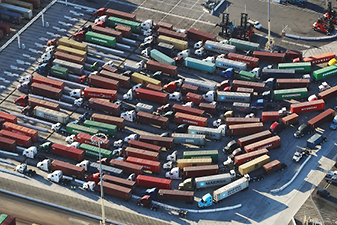|
By Dean Croke, DAT Solutions
Amazon's Prime Day event on June 21 and 22 was the biggest two-day shopping period ever for the company's third-party sellers, nearly all of which are small and medium-sized businesses. Amazon said shoppers spent more than $1.9 billion on nearly 70 million products, which is more than a 100% year-over-year increase compared to last year and just below Black Friday and Cyber Monday in terms of revenue.
While robust sales are good news for small retailers, fulfillment is a challenge. Many businesses worry that deep discounting during the two-day sales event would further deplete inventories, and that bottlenecks at ports here and abroad would keep freight from flowing into distribution centers in a timely fashion.
This is partly why spot market load volumes are more than double what they were this time last year. For carriers, this means more delays at crowded warehouses and more spot market loads for rush orders to deliver products that are in high demand and short supply.
According to the National Retail Federation (NRF)'s June 14 letter to President Biden about supply chains and the nation's retailers, disruptions and especially congestion at key maritime ports are hurting businesses and consumer confidence. "The congestion issues have not only added days and weeks to our supply chains but have led to inventory shortages impacting our ability to serve our customers," said NRF President and CEO Matthew Shay.
The letter called out five major concerns based on a survey of NFR's more than 16,000 members:
- Port and shipping delays have affected more than 97% of surveyed retailers surveyed.
- The most common challenges are U.S. port congestion, lack of carrier capacity and lack of available containers overseas.
- 70% of respondents said they have had to add two to three weeks to their supply chains.
- All respondents said transportation costs have increased and nearly 75% are passing these costs along to consumers.
- 85% of those surveyed are experiencing inventory shortages because of the ongoing supply chain disruptions.
|

With schools and offices reopening, consumer spending over the next three months is likely to top pre-pandemic levels. Apparel sales are expected to increase by 78% this year as wardrobes get a makeover and students and teachers resume in-person classes. In May, sales of health and personal care goods increased by 1.8% and clothing sales increased by 3%, according to the U.S. Census Bureau's monthly retail trade report.
The recently revised NRF annual forecast adds further weight to the idea that consumer spending will be strong all year. The initial NRF projection of 6.5% growth in retail sales in 2021 has just been revised upward to 10.5% to 13.5%. That's more than $4.44 trillion this year as the economic recovery accelerates.
What does all this mean for trucking?
We're still in a supply-driven capacity-crunch phase where carriers have pricing power. Drivers aren't yet re-entering the industry in meaningful numbers, although the addition of 24,500 new transportation jobs in June suggest recent pay increases are having an impact.
Comparing rates entering the market to those exiting in shipper routing guides, contract rates are now 37 cents a mile higher than this time last year. But more importantly, new routing guide contract rates increased by 7% in the two weeks ending July 1 compared to the prior two-week period.
Typically, dry van contract and spot rates decline from now to Thanksgiving. But that looks less likely in 2021, an untended consequence of pinched supply chains and consumers' insatiable appetite for online spending.
Dean Croke is the principal industry analyst at DAT Freight & Analytics, which operates in the industry's largest load board for spot truckload freight, and a data analytics program based on $126 billion in annual spot and contract freight transactions. For information, visit dat.com.
|


